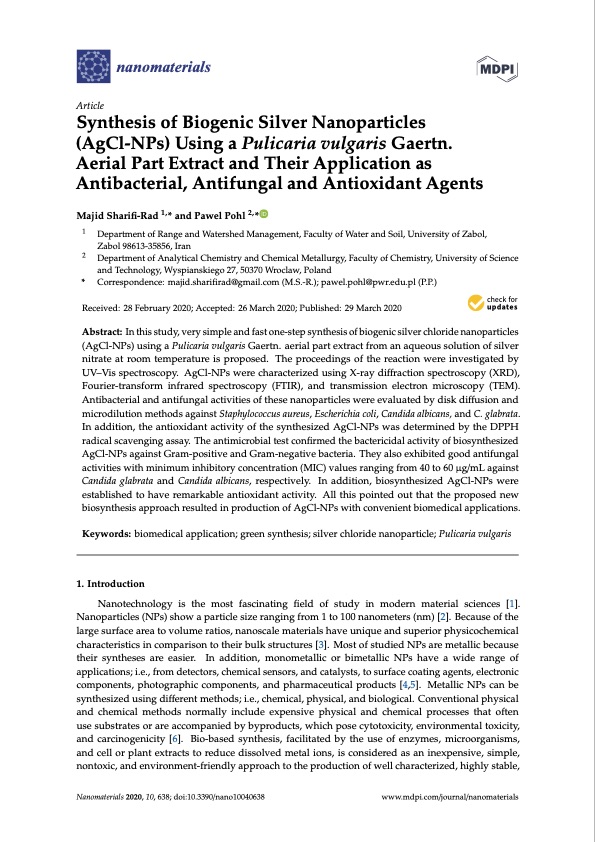
PDF Publication Title:
Text from PDF Page: 001
nanomaterials Article Synthesis of Biogenic Silver Nanoparticles (AgCl-NPs) Using a Pulicaria vulgaris Gaertn. Aerial Part Extract and Their Application as Antibacterial, Antifungal and Antioxidant Agents Majid Sharifi-Rad 1,* and Pawel Pohl 2,* 1 Department of Range and Watershed Management, Faculty of Water and Soil, University of Zabol, Zabol 98613-35856, Iran Department of Analytical Chemistry and Chemical Metallurgy, Faculty of Chemistry, University of Science and Technology, Wyspianskiego 27, 50370 Wroclaw, Poland 2 * Correspondence: majid.sharifirad@gmail.com (M.S.-R.); pawel.pohl@pwr.edu.pl (P.P.) Received: 28 February 2020; Accepted: 26 March 2020; Published: 29 March 2020 Abstract: In this study, very simple and fast one-step synthesis of biogenic silver chloride nanoparticles (AgCl-NPs) using a Pulicaria vulgaris Gaertn. aerial part extract from an aqueous solution of silver nitrate at room temperature is proposed. The proceedings of the reaction were investigated by UV–Vis spectroscopy. AgCl-NPs were characterized using X-ray diffraction spectroscopy (XRD), Fourier-transform infrared spectroscopy (FTIR), and transmission electron microscopy (TEM). Antibacterial and antifungal activities of these nanoparticles were evaluated by disk diffusion and microdilution methods against Staphylococcus aureus, Escherichia coli, Candida albicans, and C. glabrata. In addition, the antioxidant activity of the synthesized AgCl-NPs was determined by the DPPH radical scavenging assay. The antimicrobial test confirmed the bactericidal activity of biosynthesized AgCl-NPs against Gram-positive and Gram-negative bacteria. They also exhibited good antifungal activities with minimum inhibitory concentration (MIC) values ranging from 40 to 60 μg/mL against Candida glabrata and Candida albicans, respectively. In addition, biosynthesized AgCl-NPs were established to have remarkable antioxidant activity. All this pointed out that the proposed new biosynthesis approach resulted in production of AgCl-NPs with convenient biomedical applications. Keywords: biomedical application; green synthesis; silver chloride nanoparticle; Pulicaria vulgaris 1. Introduction Nanotechnology is the most fascinating field of study in modern material sciences [1]. Nanoparticles (NPs) show a particle size ranging from 1 to 100 nanometers (nm) [2]. Because of the large surface area to volume ratios, nanoscale materials have unique and superior physicochemical characteristics in comparison to their bulk structures [3]. Most of studied NPs are metallic because their syntheses are easier. In addition, monometallic or bimetallic NPs have a wide range of applications; i.e., from detectors, chemical sensors, and catalysts, to surface coating agents, electronic components, photographic components, and pharmaceutical products [4,5]. Metallic NPs can be synthesized using different methods; i.e., chemical, physical, and biological. Conventional physical and chemical methods normally include expensive physical and chemical processes that often use substrates or are accompanied by byproducts, which pose cytotoxicity, environmental toxicity, and carcinogenicity [6]. Bio-based synthesis, facilitated by the use of enzymes, microorganisms, and cell or plant extracts to reduce dissolved metal ions, is considered as an inexpensive, simple, nontoxic, and environment-friendly approach to the production of well characterized, highly stable, Nanomaterials 2020, 10, 638; doi:10.3390/nano10040638 www.mdpi.com/journal/nanomaterialsPDF Image | Synthesis of Biogenic Silver Nanoparticles Aerial Part Extract

PDF Search Title:
Synthesis of Biogenic Silver Nanoparticles Aerial Part ExtractOriginal File Name Searched:
nanomaterials-10-00638.pdfDIY PDF Search: Google It | Yahoo | Bing
Turbine and System Plans CAD CAM: Special for this month, any plans are $10,000 for complete Cad/Cam blueprints. License is for one build. Try before you buy a production license. More Info
Waste Heat Power Technology: Organic Rankine Cycle uses waste heat to make electricity, shaft horsepower and cooling. More Info
All Turbine and System Products: Infinity Turbine ORD systems, turbine generator sets, build plans and more to use your waste heat from 30C to 100C. More Info
CO2 Phase Change Demonstrator: CO2 goes supercritical at 30 C. This is a experimental platform which you can use to demonstrate phase change with low heat. Includes integration area for small CO2 turbine, static generator, and more. This can also be used for a GTL Gas to Liquids experimental platform. More Info
Introducing the Infinity Turbine Products Infinity Turbine develops and builds systems for making power from waste heat. It also is working on innovative strategies for storing, making, and deploying energy. More Info
Need Strategy? Use our Consulting and analyst services Infinity Turbine LLC is pleased to announce its consulting and analyst services. We have worked in the renewable energy industry as a researcher, developing sales and markets, along with may inventions and innovations. More Info
Made in USA with Global Energy Millennial Web Engine These pages were made with the Global Energy Web PDF Engine using Filemaker (Claris) software.
Infinity Turbine Developing Spinning Disc Reactor SDR or Spinning Disc Reactors reduce processing time for liquid production of Silver Nanoparticles.
| CONTACT TEL: 608-238-6001 Email: greg@infinityturbine.com | RSS | AMP |